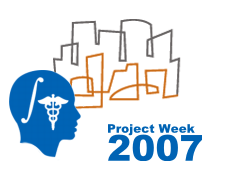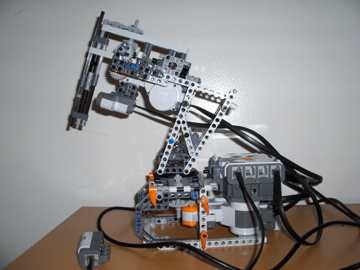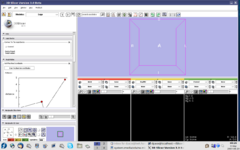Difference between revisions of "Projects/Slicer3/2007 Project Week Lego Mindstorms dissemination for IGT"
| (13 intermediate revisions by the same user not shown) | |||
| Line 1: | Line 1: | ||
{| | {| | ||
|[[Image:ProjectWeek-2007.png|thumb|320px|Return to [[2007_Programming/Project_Week_MIT|Project Week Main Page]] ]] | |[[Image:ProjectWeek-2007.png|thumb|320px|Return to [[2007_Programming/Project_Week_MIT|Project Week Main Page]] ]] | ||
| − | |[[Image: | + | |[[Image:LegoMindstorms_Slicer3.jpg ]] |
|} | |} | ||
| − | |||
__NOTOC__ | __NOTOC__ | ||
===Key Investigators=== | ===Key Investigators=== | ||
| − | * | + | * Danielle Pace |
| + | * NA-MIC Collaborators: Katie Hayes, Michael Halle, Tauseef Rehman, Marco Ruiz | ||
| Line 13: | Line 13: | ||
<div style="width: 27%; float: left; padding-right: 3%;"> | <div style="width: 27%; float: left; padding-right: 3%;"> | ||
| + | |||
<h1>Objective</h1> | <h1>Objective</h1> | ||
| − | |||
| − | + | The goal of this project is to provide a highly accessible tool that allows users to assess whether Slicer 3 meets their needs. In order to truly evaluate open-source IGT software, users must be able to experiment with the software in a hands-on fashion. Unfortunately, an accessible means of doing so is often not provided with open-source IGT software, as users' only options are usually trying out the software without any physical devices or purchasing expensive tracking devices and/or phantoms. | |
| − | |||
| − | |||
| − | |||
| − | |||
| − | + | This project uses Lego Mindstorms, an inexpensive robotics kit, to provide an assessment tool and tutorial for Slicer 3. The user will get a feel for the capabilities of Slicer 3 by setting up and executing a simulated needle biopsy using the robot. | |
| − | to | ||
| − | + | </div> | |
| − | + | <div style="width: 27%; float: left; padding-right: 3%;"> | |
| − | + | <h1>Approach, Plan</h1> | |
| − | |||
| − | |||
| − | |||
| − | |||
| − | |||
| − | |||
| − | |||
| − | |||
| − | |||
| − | |||
| − | |||
| − | |||
| − | + | Advancement will be made in this ongoing summer project with the following three goals in mind: | |
| − | + | 1) Wrap up programming a means for communication between Slicer 3 and the Lego Mindstorms robot over USB. | |
| − | + | 2) Wrap up hierarchical modelling to calculate the final needle position given the current rotation of the three motors. | |
| − | + | 3) Start and finish programming the Slicer 3 module GUI. | |
| − | |||
</div> | </div> | ||
| − | <div style="width: | + | <div style="width: 40%; float: left;"> |
| − | <h1> | + | <h1>Progress</h1> |
| − | + | 1) USB communication coding finished. | |
| − | + | 2) Hierarchical modelling almost finished as of Friday morning and will be finished by the end of the week. | |
| + | 3) Slicer 3 GUI finished (see example screenshot below): | ||
| − | + | [[Image:LegoGUIScreenshot.png|thumb|240px]] | |
| − | |||
| − | |||
| − | |||
| − | |||
</div> | </div> | ||
| Line 83: | Line 62: | ||
Contribute input here: | Contribute input here: | ||
| − | + | ||
| − | |||
===References=== | ===References=== | ||
Latest revision as of 04:54, 29 June 2007
Home < Projects < Slicer3 < 2007 Project Week Lego Mindstorms dissemination for IGT Return to Project Week Main Page |

|
Key Investigators
- Danielle Pace
- NA-MIC Collaborators: Katie Hayes, Michael Halle, Tauseef Rehman, Marco Ruiz
Objective
The goal of this project is to provide a highly accessible tool that allows users to assess whether Slicer 3 meets their needs. In order to truly evaluate open-source IGT software, users must be able to experiment with the software in a hands-on fashion. Unfortunately, an accessible means of doing so is often not provided with open-source IGT software, as users' only options are usually trying out the software without any physical devices or purchasing expensive tracking devices and/or phantoms.
This project uses Lego Mindstorms, an inexpensive robotics kit, to provide an assessment tool and tutorial for Slicer 3. The user will get a feel for the capabilities of Slicer 3 by setting up and executing a simulated needle biopsy using the robot.
Approach, Plan
Advancement will be made in this ongoing summer project with the following three goals in mind:
1) Wrap up programming a means for communication between Slicer 3 and the Lego Mindstorms robot over USB.
2) Wrap up hierarchical modelling to calculate the final needle position given the current rotation of the three motors.
3) Start and finish programming the Slicer 3 module GUI.
Progress
1) USB communication coding finished.
2) Hierarchical modelling almost finished as of Friday morning and will be finished by the end of the week.
3) Slicer 3 GUI finished (see example screenshot below):
Notes & Suggestions
Contribute input here:
